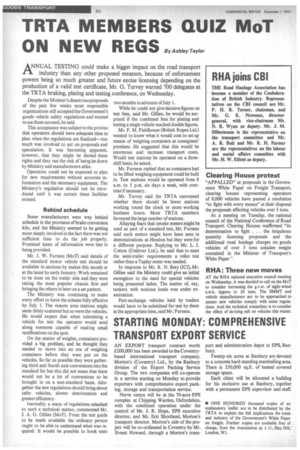TRTA MEMBERS QUIZ MoT
Page 52

If you've noticed an error in this article please click here to report it so we can fix it.
ON NEW REGS By Ashley ANNUAL TESTING could make a bigger impact on the road transport industry than any other proposed measure, because of enforcement powers being so much greater and future excise licensing depending on the production of a valid test certificate, Mr. G. Turvey warned 700 delegates at the TRTA braking, plating and testing conference, on Wednesday.
Despite the Minister's disastrous proposals of the past few weeks most responsible organizations still accepted the Government's goods vehicle safety regulations and wanted to see them succeed, he said.
This acceptance was subject to the proviso that operators should have adequate time to plan when the regulations are finalized—too much was involved to act on proposals and speculation. It was becoming apparent, however, that they might be denied these rights and they ran the risk of being let down by Ministry and manufacturers alike.
Operators could not be expected to plan for new requirements without accurate information and the necessary equipment. The Ministry's regulation should not be introduced until it was .certain these facilities existed.
Behind schedule Some manufacturers were way behind schedule in the provision of brake conversion kits, and the Ministry seemed to be getting more deeply involved in the fact there was not sufficient time to do the job properly. Promised items of information were late in being provided.
Mr. J. W. Furness (MoT) said details of the standard motor vehicle test should be available in sections by makes this month or at the latest by early January. Work remained to be done on the trailer side and they were taking the most popular chassis first and bringing the others in later on a set pattern.
The Ministry was continuing to make every effort to have the scheme fully effective by July 1. The remote area stations might seem thinly scattered but so were the vehicles. He would expect that when submitting a vehicle for test the operator would send along someone capable of making small rectifications on the spot.
On the matter of weights, containers provided a big problem, and he thought they needed to move into an era of weighing containers before they were put on the vehicles. So far as possible they were gathering third and fourth axle conversions into the standard list but this did not mean that there would not be a lot of conversions to be brought in on a non-standard basis. Altogether the new regulations should bring about safer vehicles, slower deterioration and greater efficiency.
Inevitably a maze of regulations attached to such a technical matter, commented Mr. I. A. G. Gillies (MoT). From the test guide to be made available the ordinary person ought to be able to understand what was required. It would be possible to book tests two months in advance of July 1.
While he could not give decisive figures on test fees, said Mr. Gillies, he would be surprised if the combined fees for plating and testing a single vehicle reached double figures.
Mr. F. M. Fieldhouse (British Ropes Ltd.) wanted to know what it would cost to set up means of weighing containers at consignees' premises. He suggested that this would be enormous and increase transport costs. Would test stations be operated on a threeshift basis, he asked.
Mr. Furness replied that as containers had to be lifted weighing equipment could be built in. Test stations would be operated from 8 a.m. to 5 p.m. six days a week, with overtime if necessary.
Mr. Turvey said the TRTA canvassed whether there should be fewer stations working round the clock or more working business hours. Most TRTA members favoured the large number of stations.
Allaying fears that smoke meters might be used as part of a standard test, Mr. Furness said such meters might have been seen in demonstrations at Hendon but they were for a different purpose. Replying to Mr. L. J. Cotton (Unilever Ltd.), he said that to meet the semi-trailer requirements a roller test rather than a Tapley meter was needed.
In response to Mr. R. N. Baty (ICI), Mr. Gillies said the Ministry could give an initial exemption to the need for special vehicles being presented laden. The matter of, say, tankers with noxious loads was under examination.
Part-exchange vehicles held by traders would have to be submitted for test by them at the appropriate time, said Mr. Furness.
Clearing House protest
"APPALLED" at proposals in the Government White Paper on Freight Transport, clearing houses representing operators of 8,000 vehicles have passed a resolution "to fight with every means" at their disposal the proposals affecting vehicles over 3 tons.
At a meeting on Tuesday, the national council of the National Conference of Road Transport Clearing Houses reaffirmed "its determination to fight . the iniquitous quantity licensing proposals and the additional road haulage charges on goods vehicles of over 3 tons unladen weight contained in the Minister of Transport's White Paper •'.
RHA: Three new moves
AT the RHA national executive council meeting on Wednesday, it was decided to call on the MoT to consider increasing the g.v.w. of eight-wheel s.w.b. tippers to 26 tons. The SMMT and vehicle manufacturers are to be approached to ensure new vehicles comply with noise regulations. And the technical committee is to consider the effect of de-icing salt on vehicles this winter.




























































































































































































